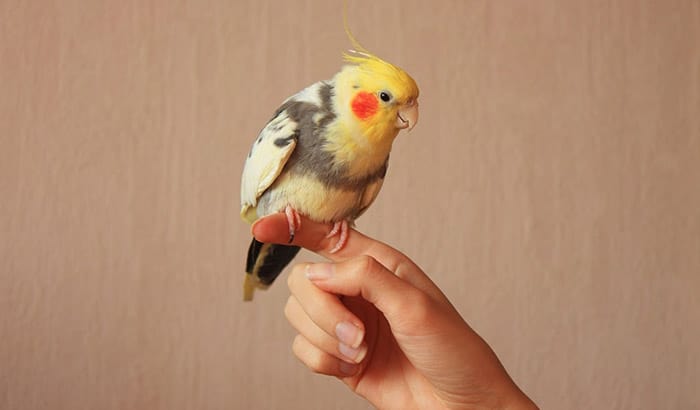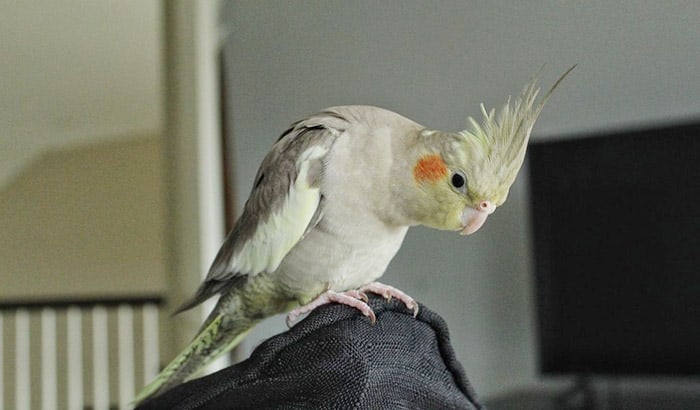Cockatiels are usually seen in pairs in the wild, and they enjoy others’ company enormously. These birds mate for life, even taking turns incubating their eggs and finding food. In captivity, they also get paired up since these sociable birds enjoy others’ company.
Cockatiels are beautiful birds with slender bodies in gray feathers and white shoulders. Yet, there are several clues, visual and behavior-wise, to distinguish the birds’ sex. If you are curious about ‘what’s the difference between male and female Cockatiels’, check out the information below.
Contents
Difference Between Male and Female Cockatiels
Female and male Cockatiels bear many differences that are rather easy to spot, from their physical attributes to behaviors. Let’s see what those clues are:
Appearance:
Both male and female Cockatiels have a yellow head, orange cheeks, white chest, brown back, black tail feathers with yellow tips (visible in flight). We can distinguish them from other species by noticing their gray wings with white bars on the outer edge of the wing’s primary covert feathers (again visible in flight).
To tell them apart from other types of birds, look for these differences in their coloration and physical traits:
- Males will generally have bright orange cheek patches, with black barring on their cheeks and yellow bars above the eyes. There is also a pattern of gray to white on the back of males’ heads that looks like they’re wearing caps or bonnets.
- On the other hand, female birds have a lighter shade of orange on their faces, a bit more yellow and gray, rather than striking orange.
- Another big difference is the coloring on their bodies. Males have more of a dark grey coloration while females appear to be lighter.
- Female Cockatiel color patterns vary based on age and location in Australia, where breeders initially found them. Some older breeding lines produce extremely colorful birds, while others produce fairly unnoticeable colors, even among female adults.
- Females tend to be duller than male adult specimens but still brighter than young chicks.
- A distinguishing feature is on their tails. There can be irregular patterns or dots on its tail in the female Cockatiels. Meanwhile, male ones do not.
Aside from their color patterns, there are several physical differences between male and female Cockatiels.
- Some males may be slightly larger than some female Cockatiels, but this does depend on certain factors such as genetics and nutrition levels during the breeding season.
- Males also have thicker tails and a more pronounced crest on their heads. The crests of males also curve inward more sharply than those of females.
Vocal Communication
Vocal is one of the key ways that Cockatiels express themselves. Cockatiel males and females have different vocalizations, making it a helpful clue to distinguish between the sexes.
- The male Cockatiel’s voice is higher pitched and nasal than the female’s voice. The male also has a loud “whistle,” which he uses to attract mates or alert other birds to danger.
- Meanwhile, the female Cockatiel’s voice is lower in pitch and has a raspier quality than the male’s. She also has a softer “coo,” which she uses to communicate with her chicks.
- Furthermore, male Cockatiels often learn to talk faster; thus they are more vocal and loud.
- On the contrary, female birds are often quiet and do not often mimic sounds like the male ones.
While the differences in their voices may be subtle, they can be easily distinguished by experienced bird owners.
Behavior
In general, the two sexes show different behaviors due to their reproductive roles. The activity level of a Cockatiel can also differ depending on their gender.
- Generally speaking, males are more active than females, and females tend to be shyer. But this again can depend on other factors such as age and whether they have been bred or not.
- For example, females who have not been bred often sit around in one spot for long periods at a time. Meanwhile, males will move around more frequently even when not breeding.
- The exception to this is when Cockatiels are young, they are equally active, no matter their gender, until they reach sexual maturity. After that point, hormones kick in, and the differences between male and female birds become more apparent.
- Males play a pivotal role in courtship and mating rituals. They are typically more aggressive towards other birds and vigorously defend their territory. Conversely, females take care of the eggs and young chicks after hatching. Because of this, female Cockatiels are better at problem-solving and remembering where food is located.
- Also, habitual masturbation is more common among male Cockatiels. When masturbating, male birds hump the given object or stand and rub their vents aggressively.
- Female Cockatiels, on the other hand, back themselves against the object. They perk their tails up while bending their bodies down.
Personality
Male Cockatiels are a bit different than females in terms of personality.
- Females are typically more territorial and can be nippy, while males are more docile and gentle. If you’re looking for a pet Cockatiel that is less aggressive and calmer, a male may be the better choice for you.
- Male Cockatiels also tend to whistle more than females do. This is often seen as a sign of happiness or contentment. So, if you’re looking for a bird that loves to sing, go with a male!
In general, there isn’t too much of a difference between Cockatiel males and females when it comes to personality. They are both lovable birds who love spending time with their humans.
Misconceptions about Male and Female Cockatiels
First of all, males indeed have brighter colors than females do. However, they also have more white spots on their feathers, making them appear lighter in color. Females tend to have darker colors with fewer white spots on their feathers.
Another misconception is that females are smaller than males when both sexes grow up to be the same size! It might also surprise you to know that the two genders aren’t different sizes until they reach puberty.
Conclusion
The difference between a Cockatiel male and female shows pretty clear in their appearances and habits. A bird’s personality also varies by gender- males can be quite territorial while females tend to be friendlier around other animals.
Still, they are both loving and affectionate animals. If you’re looking for a new pet to bring joy into your life or want to learn more about owning one before making a purchase choice, I hope this post has been helpful.


